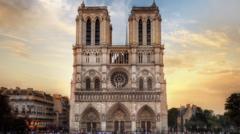The world is set to witness the restored splendor of Notre-Dame Cathedral as France's President Emmanuel Macron plans a televised preview this Friday. Nearly six years post the calamitous fire of April 2019, the Gothic masterpiece has undergone extensive repairs, promising a striking visual delight for its visitors. Accompanied by his wife, Brigitte, and Archbishop Laurent Ulrich, Macron is launching a series of ceremonies leading to the cathedral's formal reopening on December 8 and a first mass the following day.
During the televised tour, Macron will highlight the remarkable €700 million renovation project, showcasing the crafting of massive roof timbers that replace the historic frame lost in the inferno. A coveted sneak peek of the cathedral’s revitalized interior has been tightly held, but early visitors report an atmosphere of enhanced brightness and clarity. "The word to describe this day is 'splendour,'" mentioned an insider closely linked to the project, noting the pristine whiteness of the cut stone is a sight unseen for centuries.
On that tragic night of April 15, viewers globally watched in horror as flames consumed sections of the iconic structure, with the 19th-century spire collapsing amidst the crisis. Investigations suggested a cigarette left behind by workers or an electrical fault could have ignited the fire. A heroic effort from approximately 600 firefighters battling the inferno for 15 hours ultimately preserved the core structure, despite significant losses to the spire and wooden framework.
Despite the destruction, many artifacts including stained-glass windows, statues, and the revered Crown of Thorns remained intact, spurring further hopes for recovery. President Macron, witnessing the disaster firsthand, vowed to expedite rebuilding efforts and, alongside a public appeal for funds, raised over €846 million, drawn from both major corporations and compassionate individuals alike.
Directing the efforts was Jean-Louis Georgelin, a no-nonsense military general, who tragically passed in August 2023. His leadership endeared the project with commitment, leading to nearly 2,000 artisans working on the revival, leading to a significant boost for French craftsmanship and trade. The project’s first goal was ensuring a safe environment for restoration—which included the complicated task of removing melted scaffolding that fused with the stone during the fire.
A crucial choice soon arose over the approach to restoration—whether to recreate the medieval building faithfully or imprint modern influences. Ultimately, the decision leaned towards preserving the original architectural style, albeit with modern safety inclusions such as sprinklers in the new roof.
One prevailing debate concerns Macron's ambition for a modern touch on stained-glass windows in six side chapels, with artists vying for the opportunity amidst resistance from traditionalists. The renovation is being tied closely to Macron’s political narrative, providing a significant morale boost at a time of political challenge.
As the reopening approaches, the colossal efforts and dedication to restoration reveal a “collective will-power—à la française,” showcasing a united French spirit amid recovery.
During the televised tour, Macron will highlight the remarkable €700 million renovation project, showcasing the crafting of massive roof timbers that replace the historic frame lost in the inferno. A coveted sneak peek of the cathedral’s revitalized interior has been tightly held, but early visitors report an atmosphere of enhanced brightness and clarity. "The word to describe this day is 'splendour,'" mentioned an insider closely linked to the project, noting the pristine whiteness of the cut stone is a sight unseen for centuries.
On that tragic night of April 15, viewers globally watched in horror as flames consumed sections of the iconic structure, with the 19th-century spire collapsing amidst the crisis. Investigations suggested a cigarette left behind by workers or an electrical fault could have ignited the fire. A heroic effort from approximately 600 firefighters battling the inferno for 15 hours ultimately preserved the core structure, despite significant losses to the spire and wooden framework.
Despite the destruction, many artifacts including stained-glass windows, statues, and the revered Crown of Thorns remained intact, spurring further hopes for recovery. President Macron, witnessing the disaster firsthand, vowed to expedite rebuilding efforts and, alongside a public appeal for funds, raised over €846 million, drawn from both major corporations and compassionate individuals alike.
Directing the efforts was Jean-Louis Georgelin, a no-nonsense military general, who tragically passed in August 2023. His leadership endeared the project with commitment, leading to nearly 2,000 artisans working on the revival, leading to a significant boost for French craftsmanship and trade. The project’s first goal was ensuring a safe environment for restoration—which included the complicated task of removing melted scaffolding that fused with the stone during the fire.
A crucial choice soon arose over the approach to restoration—whether to recreate the medieval building faithfully or imprint modern influences. Ultimately, the decision leaned towards preserving the original architectural style, albeit with modern safety inclusions such as sprinklers in the new roof.
One prevailing debate concerns Macron's ambition for a modern touch on stained-glass windows in six side chapels, with artists vying for the opportunity amidst resistance from traditionalists. The renovation is being tied closely to Macron’s political narrative, providing a significant morale boost at a time of political challenge.
As the reopening approaches, the colossal efforts and dedication to restoration reveal a “collective will-power—à la française,” showcasing a united French spirit amid recovery.



















